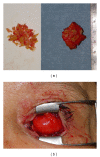Correction of anophthalmic enophthalmos with a three-staged procedure: two case reports
- PMID: 22606592
- PMCID: PMC3350191
- DOI: 10.1155/2011/731259
Correction of anophthalmic enophthalmos with a three-staged procedure: two case reports
Abstract
Surgical correction of an anophthalmic enophthalmos secondary to inappropriate repair of the eye socket involves several difficult aesthetic issues associated with long-term use of a poorly fitting prosthetic eye. In this paper, we present two cases of anophthalmic enophthalmos. During the treatment of the first patient, unsatisfactory cosmetic problems including lower eyelid retraction, hypoglobus, and severe upper eyelid ptosis were revealed. Accordingly, a three-staged procedure was performed on the second patient, including autologous augmentation of the eye socket, correction of lower eyelid retraction with a cartilage graft, and a frontalis sling procedure to correct upper eyelid ptosis.
Figures








Similar articles
-
Correction of lower eyelid ptosis in the anophthalmic orbit: a long-term follow-up.Plast Reconstr Surg. 1983 Sep;72(3):289-93. doi: 10.1097/00006534-198309000-00001. Plast Reconstr Surg. 1983. PMID: 6611750
-
Tarsal switch procedure for the surgical rehabilitation of the eyelid and socket deficiencies of the anophthalmic socket.Ophthalmic Plast Reconstr Surg. 1999 Sep;15(5):333-40. doi: 10.1097/00002341-199909000-00006. Ophthalmic Plast Reconstr Surg. 1999. PMID: 10511213
-
Correction of lower eyelid retraction with hard palate graft in the anophthalmic socket.Can J Ophthalmol. 2018 Oct;53(5):458-461. doi: 10.1016/j.jcjo.2018.01.031. Epub 2018 Apr 2. Can J Ophthalmol. 2018. PMID: 30340710
-
Anophthalmic syndrome: a review of management.Ophthalmic Plast Reconstr Surg. 2014 Sep-Oct;30(5):361-5. doi: 10.1097/IOP.0000000000000217. Ophthalmic Plast Reconstr Surg. 2014. PMID: 24988502 Review.
-
Upper eyelid retraction in the anophthalmic socket: review and survey of the Australian and New Zealand Society of Ophthalmic Plastic Surgeons (ANZSOPS).Ophthalmic Plast Reconstr Surg. 2014 Jul-Aug;30(4):309-12. doi: 10.1097/IOP.0000000000000098. Ophthalmic Plast Reconstr Surg. 2014. PMID: 24867612 Review.
References
-
- Hashikawa K, Terashi H, Tahara S. Therapeutic strategy for the triad of acquired anophthalmic orbit. Plastic and Reconstructive Surgery. 2007;119(7):2182–2188. - PubMed
-
- Minagawa T, Maeda T, Yamao T, Hayashi T. Diced cartilage ball graft wrapped in fascia for autologous augmentation of an eye socket. Journal of Japan Society of Plastic and Reconstructive Surgery. 2010;30(9):491–494.
-
- Carraway JH, Mellow CG, Mustarde JC. Use of cartilage graft for an orbital socket implant. Annals of Plastic Surgery. 1990;24(2):139–148. - PubMed
-
- Ashworth JL, Rhatigan M, Brammar R, Sunderland S, Leatherbarrow B. A clinical study of the hydroxyapatite orbital implant. European Journal of Ophthalmology. 1997;7(1):1–8. - PubMed
-
- Yanaga H, Mori S. Eyelids and eye socket reconstruction using the expanded forehead flap and scapha composite grafting. Plastic and Reconstructive Surgery. 2001;108(1):8–16. - PubMed
Publication types
LinkOut - more resources
Full Text Sources

